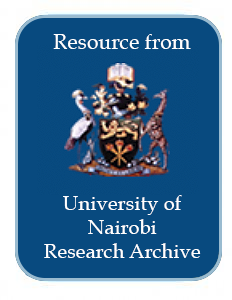Location
Our Vision is to be a world-class university committed to scholarly excellence.
Our Mission is to provide quality university education and training and to embody the aspirations of the Kenyan people and the global community through creation, preservation, integration, transmission and utilization of knowledge.
Core Values
In order to realize the above vision and mission, certain shared values shall be nurtured. There is great need for the University to be guided by the right values derived from the virtues and moral standards of the Kenyan and wider society.
Core Functions
Teaching and Learning: The university offers innovative , relevant and market driven academic programmes , both at undergraduate and postgraduate levels with inbuilt quality control systems the university also provides an environment and policy framework for undertaking high quality and relevant research
Members:
Resources
Displaying 276 - 280 of 298The impact on Nairobi national park of changes in land use in adjacent areas
The future of wildlife in our conserved
ecosystem depends largely on the future planning for
land use in the adjacent areas. All National Parks
and game reserves in Kenya, as they now exist, are in
some degree or other dependent on the relationship
between land use changes and wildlife in the areas
sorrounding them. If the surrounding lands deteriorate
through misuse, or if, in the management no consideration
is given to wildlife, the national parks and game
reserves will suffer, or,even be destroyed. Nairobi
Factors Related to Stock Ownership and Population Movements and Perceptions on Land Pressure and Other Environmental Changes Among the Rendille in Marsabit District
The effect of narrow grass strips in controlling soil erosion and runoff on sloping land
The study was carried out on twelve runoff
plots installed at Kabete Campus Field Station,
University of Nairobi, on a 10% natural slope of
eutric Nitisol to assess the effect of grass strips
in controlling soil loss and runoff on sloping land.
Four treatments, a control plot without grass strip
and three different widths (0.5, 1.0 and 1.5 m.) of
Nandi setaria (Setaria anceps), were tested under
natural rainfall during 1982 and 1983, simulated
runoff, and simulated rainfall of 80 mm/hr.




